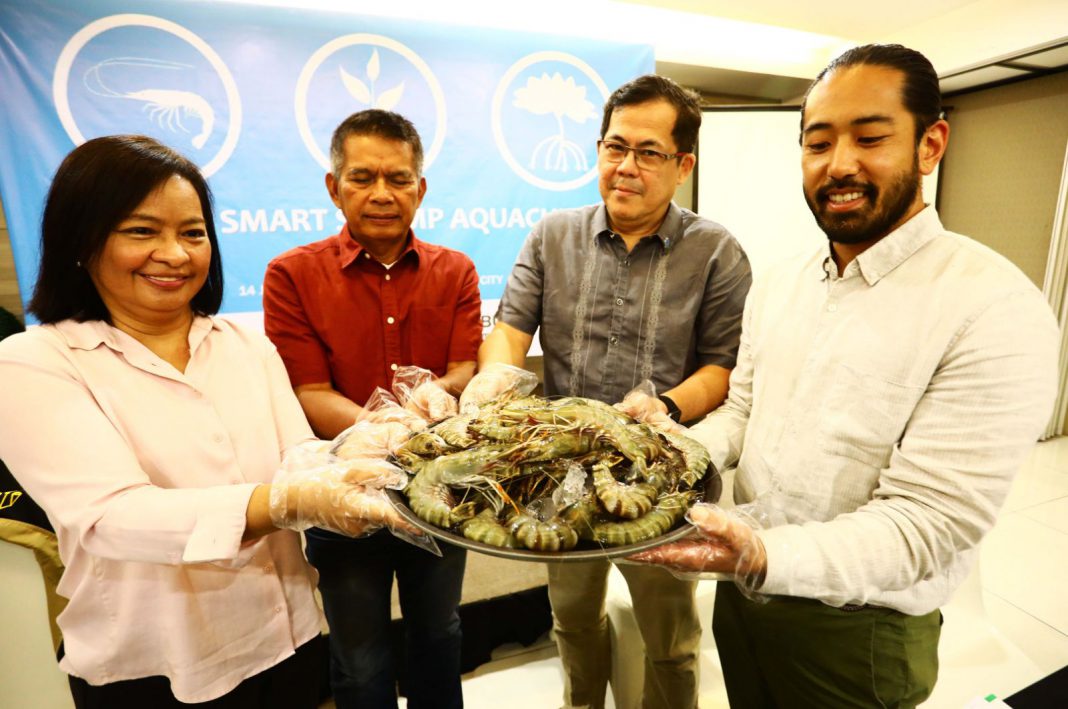Photo shows from left, Dinna Umengan (Executive Director, Tambuyog Development Center), Eduardo Gongona (National Director, Bureau of Fisheries and Aquatic Resources – BFAR), Enrique Nuñez (Country Executive Director, Conservation International Philippines) and Garrett Goto (Aquaculture Manager, Conservation International Center for Oceans), hold a plate full of farmed shrimp during the Climate Smart hrimp Aquaculture Forum held at Sequoia Hotel in Quezon City, on June 14, 2022.

With the Global farmed shrimp production grew by more than 10,000 percent over the last three decades to produce an estimated 6.5 million metric tons of shrimp in 2018. This dramatic growth may not be something to be happy about as there is a trade off that many people do not realize.

The massive growth in shrimp production has taking its toll to the ecosystems, because it has been contributing to the destruction of more than 50 percent of mangrove forests globally, and causing significant harm to the environment and the climate resilience of coastal communities.
While deforestation from the expansion of aquaculture has slowed substantially, pollution impacts persist, and the historical ecosystem benefits of mangroves remain lost. In the Philippines, approximately 200,000 hectares of mangroves, almost 40 percent of the historical total, have been damaged or degraded by aquaculture activities and industrial development. Mangroves serve as natural structural barriers that reduce coastal erosion, provide habitat for aquatic and terrestrial species, and dissipate wave energy and storm surges.
Unknown to many, about 80% of Filipinos that live in coastal municipalities will become increasingly vulnerable to typhoons that are likely to increase in intensity and occurrence with climate change. Restoring coastal ecosystems, like mangroves and coastal wetlands, enhances coastal resilience through climate adaptation and habitat benefits while also improving water quality in receiving waters through filtration of pollutants and absorption of nutrients. However, restoration at scale requires substantial funding, and parcels available for restoration are limited.
At the same time, shrimp aquaculture is an important industry in the Philippines (more than 66,500 tonnes produced in 2019; 9th largest producer globally) which provides benefits to local livelihoods and food security. Recent shrimp prices have fluctuated dramatically and have generally decreased over the last decade, leaving farmers grappling with ways to reduce costs or increase production volumes to remain profitable. Intensification, where farmers use technology, improved management practices, and additional production inputs to increase yields while reducing costs, is largely seen as a requirement to remain cost competitive. But many farmers face barriers to intensification, including access to capital, expertise, and guaranteed markets.
Preemptive, innovative, and scalable adaptation solutions are needed to reduce climate impacts to communities and their future generations. This project reverses the paradigm of shrimp aquaculture as an agent of mangrove deforestation and pollution and instead couples sustainable intensification of shrimp farming with mangrove restoration to provide biodiversity and community climate adaptation benefits.
The Climate Smart Shrimp Aquaculture Forum was attended by shrimp aquaculture farm operators and workers, non-government organizations and BFAR national and regional officers, the forum aims to promote the Climate Smart Shrimp (CSS) Aquaculture Model, a pioneering approach to responsible production and to sustainably intensify shrimp aquaculture and restore mangroves. BFAR Director Gongona said in his speech to participants, the Bureau is in the final steps of publication of the Industry Roadmap for Shrimp for 2021-2040, which aims to achieve a sustainable and equitable shrimp industry adhering to a socially responsible and environmentally sound production system. Conservation International, with Tambuyog Development Center, emphasized that the CSS model is a timely initiative that integrates climate resilience by integrating coastal mangrove ecosystems in its model of shrimp farm aquaculture production.














